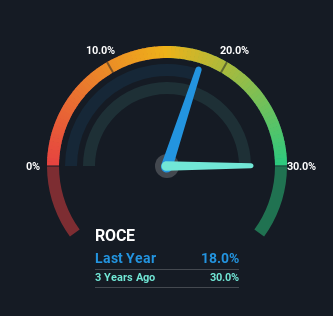- India
- /
- Metals and Mining
- /
- NSEI:DPWIRES
The Returns On Capital At D.P. Wires (NSE:DPWIRES) Don't Inspire Confidence
There are a few key trends to look for if we want to identify the next multi-bagger. Firstly, we'll want to see a proven return on capital employed (ROCE) that is increasing, and secondly, an expanding base of capital employed. This shows us that it's a compounding machine, able to continually reinvest its earnings back into the business and generate higher returns. In light of that, when we looked at D.P. Wires (NSE:DPWIRES) and its ROCE trend, we weren't exactly thrilled.
Understanding Return On Capital Employed (ROCE)
For those that aren't sure what ROCE is, it measures the amount of pre-tax profits a company can generate from the capital employed in its business. The formula for this calculation on D.P. Wires is:
Return on Capital Employed = Earnings Before Interest and Tax (EBIT) ÷ (Total Assets - Current Liabilities)
0.18 = ₹409m ÷ (₹2.6b - ₹352m) (Based on the trailing twelve months to June 2024).
So, D.P. Wires has an ROCE of 18%. In absolute terms, that's a pretty normal return, and it's somewhat close to the Metals and Mining industry average of 16%.
Check out our latest analysis for D.P. Wires

While the past is not representative of the future, it can be helpful to know how a company has performed historically, which is why we have this chart above. If you'd like to look at how D.P. Wires has performed in the past in other metrics, you can view this free graph of D.P. Wires' past earnings, revenue and cash flow.
So How Is D.P. Wires' ROCE Trending?
When we looked at the ROCE trend at D.P. Wires, we didn't gain much confidence. Around five years ago the returns on capital were 27%, but since then they've fallen to 18%. And considering revenue has dropped while employing more capital, we'd be cautious. This could mean that the business is losing its competitive advantage or market share, because while more money is being put into ventures, it's actually producing a lower return - "less bang for their buck" per se.
On a related note, D.P. Wires has decreased its current liabilities to 13% of total assets. So we could link some of this to the decrease in ROCE. What's more, this can reduce some aspects of risk to the business because now the company's suppliers or short-term creditors are funding less of its operations. Some would claim this reduces the business' efficiency at generating ROCE since it is now funding more of the operations with its own money.
The Key Takeaway
From the above analysis, we find it rather worrisome that returns on capital and sales for D.P. Wires have fallen, meanwhile the business is employing more capital than it was five years ago. The market must be rosy on the stock's future because even though the underlying trends aren't too encouraging, the stock has soared 685%. Regardless, we don't feel too comfortable with the fundamentals so we'd be steering clear of this stock for now.
One more thing to note, we've identified 2 warning signs with D.P. Wires and understanding them should be part of your investment process.
For those who like to invest in solid companies, check out this free list of companies with solid balance sheets and high returns on equity.
New: Manage All Your Stock Portfolios in One Place
We've created the ultimate portfolio companion for stock investors, and it's free.
• Connect an unlimited number of Portfolios and see your total in one currency
• Be alerted to new Warning Signs or Risks via email or mobile
• Track the Fair Value of your stocks
Have feedback on this article? Concerned about the content? Get in touch with us directly. Alternatively, email editorial-team (at) simplywallst.com.
This article by Simply Wall St is general in nature. We provide commentary based on historical data and analyst forecasts only using an unbiased methodology and our articles are not intended to be financial advice. It does not constitute a recommendation to buy or sell any stock, and does not take account of your objectives, or your financial situation. We aim to bring you long-term focused analysis driven by fundamental data. Note that our analysis may not factor in the latest price-sensitive company announcements or qualitative material. Simply Wall St has no position in any stocks mentioned.
About NSEI:DPWIRES
D.P. Wires
Manufactures and supplies steel wires, plastic pipes, and plastic films for oil and gas, power, environment, civil, energy, automobile, infrastructure, and other industries in India and internationally.
Excellent balance sheet and good value.
Similar Companies
Market Insights
Community Narratives


Recently Updated Narratives


MINISO's fair value is projected at 26.69 with an anticipated PE ratio shift of 20x


The Quiet Giant That Became AI’s Power Grid


Nova Ljubljanska Banka d.d will expect a 11.2% revenue boost driving future growth
Popular Narratives


The company that turned a verb into a global necessity and basically runs the modern internet, digital ads, smartphones, maps, and AI.


MicroVision will explode future revenue by 380.37% with a vision towards success



